BASIC MATHS
- what is Natural Number.??
Eg.1,2,3,4,5,......etc..
2. what is Whole Number...??
ANS: It is the number which starts from 0.
Eg.0,1,2,3,4,5,......etc..
3. what is Prime number and composite number..??
ANS: A Prime Number can be divided evenly only by 1 or itself.
And it must be a whole number greater than 1.- When a number can be divided up evenly it is a Composite Number
- When a number can not be divided up evenly it is a Prime Number
Example:
6 can be divided evenly by 2, or by 3:6 = 2 × 3Like this:
or  divided into 2 groupsdivided into 3 groupsBut 7 cannot be divided up evenly:
divided into 2 groupsdivided into 3 groupsBut 7 cannot be divided up evenly:
TYPES OF FRACTIONS
Proper Fractions
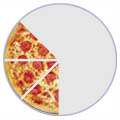 |
A Proper Fraction has a top number
less than its bottom number | |
| 3/8 | ||
(Three-Eighths)
|
Examples
| 3/8 | 1/4 | 14/15 | 4/5 |
See how the top number is smaller than the bottom number in each example? That makes it a Proper Fraction.
Three Types of Fractions
There are three types of fraction:

Fractions
A Fraction (such as 3/8) has two numbers:
| Numerator |
| Denominator |
The top number is the Numerator, it is the number of parts you have.
The bottom number is the Denominator, it is the number of parts the whole is divided into.
The bottom number is the Denominator, it is the number of parts the whole is divided into.
So we can define the three types of fractions like this:
| Proper Fractions: | The numerator is less than the denominator |
|---|---|
| Examples: 1/3, 3/4, 2/7 | |
| Improper Fractions: | The numerator is greater than (or equal to) the denominator |
| Examples: 4/3, 11/4, 7/7 | |
| Mixed Fractions: | A whole number and proper fraction together |
| Examples: 1 1/3, 2 1/4, 16 2/5 |
Proper Fractions
So, a proper fraction is just a fraction where the numerator (the top number) is less than the denominator (the bottom number). Here are some examples of proper fractions:
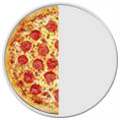 | 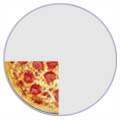 |  |
| 1/2 | 1/4 | 3/8 |
(One-Half)
|
(One-Quarter)
|
(Three-Eighths)
|
Improper Fractions
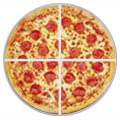 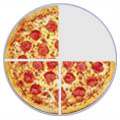 | ||
|
An Improper Fraction has a top number larger than (or equal to) the bottom number.
It is "top-heavy"
It is "top-heavy"
More Examples
| 3 | 7 | 16 | 15 | 99 | ||||
| 2 | 3 | 15 | 15 | 5 |
See how the top number is bigger than (or equal to) the bottom number?
That makes it an Improper Fraction, (but there is nothing wrong about Improper Fractions).
That makes it an Improper Fraction, (but there is nothing wrong about Improper Fractions).
Improper Fraction
So an improper fraction is a fraction where the top number (numerator) is greater than or equal to the bottom number (denominator): it is top-heavy.
 4/4 |
Can be Equal
What about when the numerator is equal to the denominator? For example 4/4 ?
Well it is the same as a whole, but it is written as a fraction, so most people agree it is a type of improper fraction.
Improper Fractions or Mixed Fractions
We can use either an improper fraction or a mixed fraction to show the same amount. For example 1 3/4 = 7/4, shown here:
| 1 3/4 | 7/4 | |
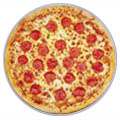  | = |   |
Converting Improper Fractions to Mixed Fractions
To convert an improper fraction to a mixed fraction, follow these steps:
| |
Converting Mixed Fractions to Improper Fractions
To convert a mixed fraction to an improper fraction, follow these steps:
| |
Mixed Fractions
(Also called "Mixed Numbers")


1 3 4
(one and three-quarters)
A Mixed Fraction is a whole number and a proper fraction combined.
such as 1 3/4 .
  | |||
|
Examples
2 3/8 7 1/4 1 14/15 21 4/5
See how each example is made up of a whole number and a proper fraction together? That is why it is called a "mixed" fraction (or mixed number).
| 2 3/8 | 7 1/4 | 1 14/15 | 21 4/5 |
See how each example is made up of a whole number and a proper fraction together? That is why it is called a "mixed" fraction (or mixed number).
Equivalent Fractions
Equivalent Fractions have the same value, even though they may look different.
These fractions are really the same:
| = |
| = |
|
Why are they the same? Because when you multiply or divide both the top and bottom by the same number, the fraction keeps it's value.
The rule to remember is:
"Change the bottom using multiply or divide,
And the same to the top must be applied"
And the same to the top must be applied"
So, here is why those fractions are really the same:
| × 2 | × 2 | |||
| 1 | = | 2 | = | 4 |
| 2 | 4 | 8 | ||
| × 2 | × 2 | |||
| 1/2 | 2/4 | 4/8 | ||
 | = | 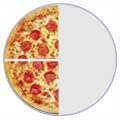 | = | 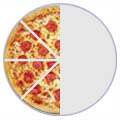 |
SIMPLIFYING FRACTIONS
To simplify a fraction, divide the top and bottom by the highest number that
can divide into both numbers exactly.
can divide into both numbers exactly.
Method 1
Divide both the top and bottom of the fraction by the Greatest Common Factor (you have to work it out first!).
No comments:
Post a Comment